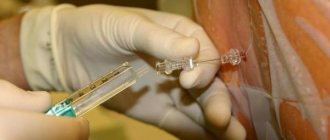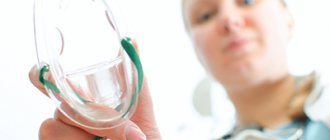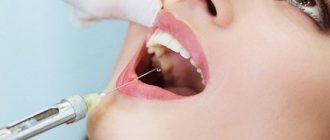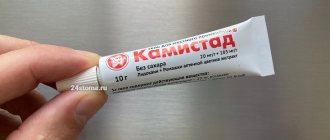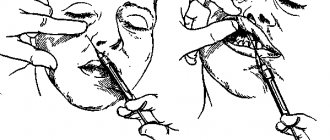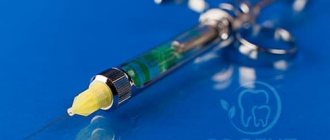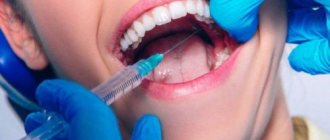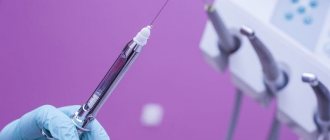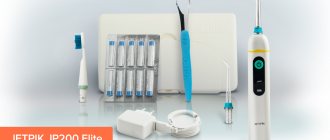Local anesthesia in dentistry: types and preparations
In therapeutic and surgical dentistry, various types and techniques of pain relief are used. These include conduction, intracanal, intraligamentous, etc. They differ in the place of application of the anesthetic and the characteristics of administration, as well as the duration of the effect.
In modern dental clinics, carpule anesthesia is used: the anesthetic is supplied in disposable carpules - cartridges in which painkillers are mixed in the required proportions. They are inserted into syringes with screw-on disposable needles. This makes it possible to ensure sterility, since the doctor does not need to open the containers - contact of the drug with air is excluded.
Conductor
Conduction anesthesia is designed to temporarily block the nerve that transmits the pain signal. This makes it possible to numb several teeth at once, since the sensitivity of a certain area of the jaw is lost. This type of anesthesia is used in cases where it is necessary to remove or treat 2-3 teeth located nearby. It is also used for operations on soft tissues. This anesthesia lasts for at least one and a half hours.
Application anesthesia
Application anesthesia is a type of non-injection anesthesia. Apply the product with your finger or a cotton swab to the selected area. Absorbing into soft tissues to a depth of 3 mm, the medicine can reduce their sensitivity for a short period of time. Most often, this method is used to make the injection painless.
There is another form of drug release - in the form of an aerosol. However, such drugs are used less frequently because there is a possibility of inhalation and the components entering the bloodstream.
Infiltration
There are two types: direct (introduction of the drug under the mucous membrane near the teeth), indirect (introduction into the surrounding tissues). In the first case, the effect is more local, in the second, a larger area is anesthetized.
Infiltration anesthesia is often used for the teeth of the upper jaw. The alveolar processes have a less dense structure, so anesthesia is effective within one hour. In most cases, this is quite enough to perform many procedures, such as treating deep caries, filling root canals, etc.
Intraligamentary
It is also called intraligamentous. This anesthesia differs in that when administering the drug, the doctor applies more pressure so that the drug can be distributed in the periodontal tissues and penetrate into the intraosseous space. This type of pain relief begins to work in less than a minute. However, its effect is short-lived: up to 30 minutes. The administration of the medicine is practically painless, and there is no numbness of the soft tissues. Intraligamentous anesthesia can be used for the extraction and preparation (grinding) of teeth.
Spongy
Also called intraosseous anesthesia, one of the most complex types. It is used when other methods demonstrate ineffectiveness or are impossible. Allows you to anesthetize the process of removing molars and perform interventions on the alveolar processes. The doctor first dissects the mucous membrane and makes a small hole in the bone tissue using a dental bur. Afterwards, a needle is inserted into it, and the anesthetic medicine is supplied to the spongy substance of the jaw. This anesthesia lasts for up to one hour.
General anesthesia in dentistry
General anesthesia in dentistry is used when long-term, serious treatment is necessary. This solution is relevant in cases that require the removal of several teeth at once, or complex interventions on the jaw. An indication for the use of anesthesia can also be a strong fear of the dentist and the upcoming manipulations. It is also advisable to resort to anesthesia if the patient cannot adequately interact with the doctor, for example, in the presence of a neuropsychiatric disease, epilepsy, etc.
An alternative to anesthesia is sedation: it can be used as a way to improve mood, relieve anxiety, and get rid of the fear of medical manipulation. The patient is conscious, but half asleep. Sedation promotes calm, psycho-emotional balance, and normal perception of the specialist’s actions. But this is not pain relief, so this method is combined with local anesthesia.
The emotional component of the response, created by a feeling of fear and fear of pain, its anticipation, often causes an aggravation of perception in patients, reaching in some cases the transformation of tactile irritations into painful ones, and weak painful ones into strong ones. T.E. Shishniashvili (1979) writes that sudden death, which occurs even against the background of complete health, can be caused precisely by emotional stress. As for fainting, which occurs as a result of a psychoreflex vascular crisis due to fear of upcoming manipulation, they are observed on average in 2% of dental patients. Preoperative emotional stress leads to changes in the strength, rhythm and frequency of heart contractions (HR), respiratory rate (RR), and blood pressure (BP). Skin temperature changes in patients awaiting a dental appointment: according to N.I. Naenko (1976) it increases, and V.A. Safronov and T.A. Nemchin (1970, 1983) noted both its increase and decrease. MJ Gang, L. Tefl (1975) report quantitative changes in some physiological parameters in anxious patients: heart rate and respiratory rate can increase by 2.5-3 times, blood pressure - by 10-25 mm Hg. Art., and heart rate changes by 10-15 beats/min even from the sound of a drill.With emotional stress, the galvanic skin reflex, sweating, the level of sugar and histamine in the blood also increase, metabolism and electrocutaneous resistance change, dry mouth, diarrhea are noted, and the blood picture changes. The presence of pronounced emotional stress in preoperative dental patients is reflected in changes in the function of the sympathetic-adrenal and pituitary-adrenal systems and in characteristic changes in the physiological functions of the body that are regulated by these systems. Therefore, the level of adrenaline, norepinephrine and corticosteroids in the blood and urine in patients experiencing fear of dental treatment is significantly higher than in control groups. Changes in patients' hormonal levels, gas exchange, and hemodynamics complicate the work of the dentist, increase the degree of operational risk (especially in diseases of the cardiovascular system, bronchial asthma, endocrinopathies, psychoses), and lead to the same direction of energy metabolism as multiple inflammatory processes.
Tooth extraction surgery in patients with cardiovascular pathology can cause a two-phase reaction in blood pressure changes. It increases in the first phase in response to intervention (operation - anesthesia), and, according to ECG data, severe hypoxia of the heart muscle develops, similar to that in the early stages of a heart attack. In the second phase, a rise in blood pressure is observed 5-6 hours after tooth extraction surgery. During this period, the ECG reveals a picture of coronary insufficiency. All of the above factors contribute to the development of pathological conditions in patients with concomitant diseases during an outpatient dental appointment, which requires the dentist to have knowledge and ability to prevent the development of stressful conditions through effective premedication, and, if necessary, provide emergency care at the prehospital stage.
When anesthesia is not used:
Contraindications to general anesthesia in dentistry are divided into relative and absolute. The first category includes exacerbation of chronic diseases, infectious diseases (Flu, herpes virus infection, etc.), pregnancy.
Anesthesia is absolutely contraindicated in the following cases:
- heart failure;
- serious kidney and liver diseases;
- endocrine disorders;
- respiratory problems, etc.
Therefore, preparation for general anesthesia is more serious: you will first need to undergo a comprehensive examination and consult with a general practitioner to assess your health and readiness for such a procedure.
Contraindications to anesthesia in dentistry
Anesthesia in dentistry has some contraindications: allergic reactions to anesthetic components, individual intolerance. Side effects are mainly associated with the components of the solutions - vasoconstrictors, or vasoconstrictors, as well as stabilizers and preservatives. Therefore, the doctor is especially careful when choosing an anesthetic for patients with chronic diseases: endocrine, cardiovascular. Preference is given to drugs in which vasoconstrictor components are present in minimal quantities or are absent altogether.
To determine an allergic reaction, a preliminary examination by an allergist may be required. Based on the results of diagnosis and allergy testing, the specialist selects a safe local anesthetic. If reactions are observed to all local agents, general anesthesia may be used.
Indications
Most dental procedures are performed under local anesthesia.
Its use is mandatory in the following cases:
- Treatment of pulpitis (first visit)
- Periodontal operations (closed and open curettage, gingivoplasty, elimination of gum recession, guided tissue regeneration)
- Prosthetics of vital (living) teeth with fixed structures (crowns, inlays, onlays, bridges)
- Tooth extraction, implantation, bone tissue augmentation, tooth-preserving operations (apex resection, root amputation, hemisection), making incisions for periostitis, pericoronitis, opening abscesses and phlegmons, removing cysts and tumors
In some situations, anesthesia is mainly used, but patients with reduced sensitivity can do without it:
- Treatment of caries, wedge-shaped defects, non-carious lesions, periodontitis
Procedures that most often do not require anesthesia, but particularly sensitive patients may require:
- Professional oral hygiene
- Restoration of pulpless teeth (both fillings and crowns or inlays)
- Removable prosthetics (if the gag reflex is increased, there may be a need for mucosal anesthesia)
Anesthesia is not recommended:
- Oral examination
- Preventive measures (fluoride varnish applications, fissure sealing)
- Teeth whitening
- Orthodontic treatment
Children often tolerate tooth preparation for caries much easier than an injection into the gum. Therefore, you should not necessarily give an injection on your first visit before starting treatment. It makes more sense to try drilling without anesthesia and switch to it only if the child complains of pain. Compassionate parents, do not worry that your child may experience hellish pain and refuse further treatment. Dentin sensitivity in children is less than in adults. The likelihood of getting psychological trauma from an injection is higher.
Diagnostic local anesthesia is used to identify the diseased tooth. When several adjacent teeth are severely damaged, it is difficult for both the patient and the doctor to determine the source of pulpal pain. In order not to depulpate them all, you can give one anesthesia and wait. If the pain has passed, it should be treated first; if not, anesthetize the next tooth and check the reaction.
